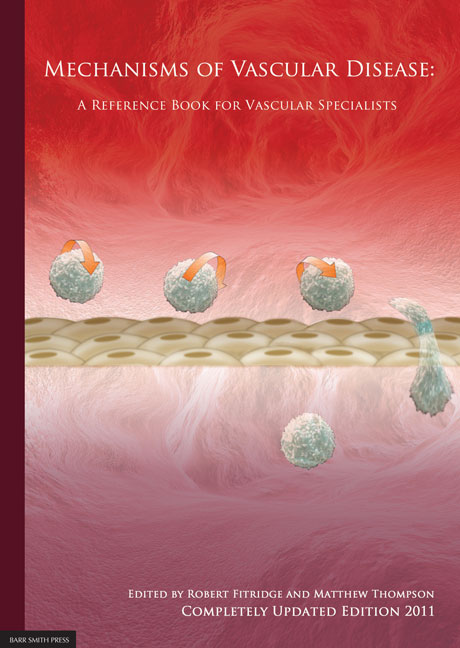Book contents
- Frontmatter
- Contents
- List of Contributors
- Detailed Contents
- Acknowledgements
- Abbreviation List
- 1 Endothelium
- 2 Vascular smooth muscle structure and function
- 3 Atherosclerosis
- 4 Mechanisms of plaque rupture
- 5 Current and emerging therapies in atheroprotection
- 6 Molecular approaches to revascularisation in peripheral vascular disease
- 7 Biology of restenosis and targets for intervention
- 8 Vascular arterial haemodynamics
- 9 Physiological Haemostasis
- 10 Hypercoagulable States
- 11 Platelets in the pathogenesis of vascular disease and their role as a therapeutic target
- 12 Pathogenesis of aortic aneurysms
- 13 Pharmacological treatment of aneurysms
- 14 Pathophysiology of Aortic dissection and connective tissue disorders
- 15 Biomarkers in vascular disease
- 16 Pathophysiology and principles of management of vasculitis and Raynaud's phenomenon
- 17 SIRS, sepsis and multiorgan failure
- 18 Pathophysiology of reperfusion injury
- 19 Compartment syndromes
- 20 Pathophysiology of pain
- 21 Post-amputation pain
- 22 Treatment of neuropathic pain
- 23 Principles of wound healing
- 24 Pathophysiology and principles of varicose veins
- 25 Chronic venous insufficiency and leg ulceration: Principles and vascular biology
- 26 Pathophysiology and principles of management of the diabetic foot
- 27 Lymphoedema – Principles, genetics and pathophysiology
- 28 Graft materials past and future
- 29 Pathophysiology of vascular graft infections
- Index
1 - Endothelium
Published online by Cambridge University Press: 05 June 2012
- Frontmatter
- Contents
- List of Contributors
- Detailed Contents
- Acknowledgements
- Abbreviation List
- 1 Endothelium
- 2 Vascular smooth muscle structure and function
- 3 Atherosclerosis
- 4 Mechanisms of plaque rupture
- 5 Current and emerging therapies in atheroprotection
- 6 Molecular approaches to revascularisation in peripheral vascular disease
- 7 Biology of restenosis and targets for intervention
- 8 Vascular arterial haemodynamics
- 9 Physiological Haemostasis
- 10 Hypercoagulable States
- 11 Platelets in the pathogenesis of vascular disease and their role as a therapeutic target
- 12 Pathogenesis of aortic aneurysms
- 13 Pharmacological treatment of aneurysms
- 14 Pathophysiology of Aortic dissection and connective tissue disorders
- 15 Biomarkers in vascular disease
- 16 Pathophysiology and principles of management of vasculitis and Raynaud's phenomenon
- 17 SIRS, sepsis and multiorgan failure
- 18 Pathophysiology of reperfusion injury
- 19 Compartment syndromes
- 20 Pathophysiology of pain
- 21 Post-amputation pain
- 22 Treatment of neuropathic pain
- 23 Principles of wound healing
- 24 Pathophysiology and principles of varicose veins
- 25 Chronic venous insufficiency and leg ulceration: Principles and vascular biology
- 26 Pathophysiology and principles of management of the diabetic foot
- 27 Lymphoedema – Principles, genetics and pathophysiology
- 28 Graft materials past and future
- 29 Pathophysiology of vascular graft infections
- Index
Summary
INTRODUCTION
The endothelium, first described over 100 years ago as an inert anatomical barrier between blood and the vessel wall, is now recognized as a dynamic organ with secretory, synthetic, metabolic, and immunologic functions. Forming a continuous lining to every blood vessel in the body, endothelial cells play an obligatory role in modulating vascular tone and permeability, angiogenesis, and in mediating haemostatic, inflammatory and reparative responses to local injury. To fulfil these roles the endothelium is highly dynamic, continuously responding to spatial and temporal changes in mechanical and biochemical stimuli. Such responsiveness is affected through receptors for growth factors, lipoproteins, platelet products and circulating hormones, which regulate changes in protein and mRNA expression, cell proliferation and migration or the release of vasoactive and inflammatory mediators.
All vascular endothelial cells have a common embryonic origin but show clear bed-specific heterogeneity in morphology, function, gene and protein expression, determined by both environmental stimuli and epigenetic features acquired during development. Thus, the endothelium should not be regarded as a homogenous tissue but rather a conglomerate of distinct populations of cells sharing many common functions but also adapted to meet regional demands.
The continuous endothelial cell layer provides an uninterrupted barrier between the blood and tissues in the majority of blood vessels and ensures tight control of permeability of the blood-brain barrier. In regions of increased trans-endothelial transport such as capillaries of endocrine glands and the kidney, the presence of fenestrae, transcellular pores approximately 70 nm in diameter with a thin fenestral diaphragm across their opening, facilitate the selective permeability required for efficient absorption, secretion, and filtering.
- Type
- Chapter
- Information
- Mechanisms of Vascular DiseaseA Reference Book for Vascular Specialists, pp. 1 - 12Publisher: The University of Adelaide PressPrint publication year: 2011
- 1
- Cited by



